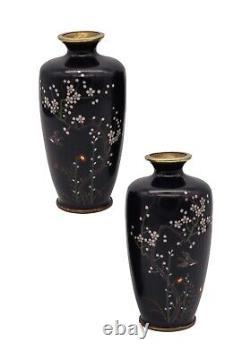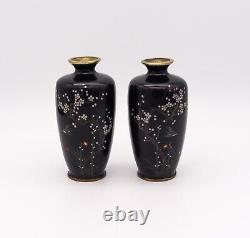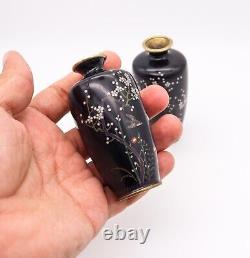
- Home
- Age
- 1800-1849 (10)
- 1850-1899 (855)
- 1868 - 1912 (5)
- 1868-1912 (38)
- 1870-1930 (7)
- 1880-1912 (8)
- 1880-1920 (4)
- 1890-1910 (6)
- 19th Century (20)
- 20th Century (6)
- Ca 1900 (6)
- Circa 1920 (5)
- Early 20th Century (49)
- Late 19th Century (30)
- Meiji (16)
- Meiji Period (8)
- Post-1940 (350)
- Unknown (96)
- 1900 (10)
- 1900-1940 (645)
- ... (1941)
- Maker
- Ando (42)
- Ando Cloisonne (20)
- Ando Jubei (28)
- Ando Jubei Nagoya (7)
- Ando Workshop (22)
- Cloisonne (21)
- Gonda Hirosuke (6)
- Hiroaki Oota (8)
- Japan (36)
- Japanese (10)
- Japanese Craftsman (165)
- Kumeno Teitaro (9)
- Sato (28)
- Shuzo (9)
- Tamura (8)
- Unknown (192)
- Unknown Artist (15)
- Unmarked (5)
- Unsigned (21)
- Yamamoto (6)
- ... (3457)
- Material
- Style
- Theme
- Type
Ota Jinnoei 1890 Imperial Meiji Period Pair Of Cloisonne Cabinet Vases







Pair of cloisonne vases designed by. These vases has been carefully crafted at the atelier of the cloisonne master Ota Jinnoei. Made in silvered bronze with applications of high polished cloisonne enamel. Worked in silver wire and decorated with organic motifs of flowers trees and little birds.
Weight : 73.75 Grams, (47.27 Dwt). Measurements : 89 mm by 50.8 mm (3.5 x 2 Inches). Hallmarks : Both are stamped under the base with the maker's mark monogram associated to. Meiji period, is an era of Japanese history that extended from October 23, 1868 to July 30, 1912. The Meiji era was the first half of the Empire of Japan, when the Japanese people moved from being an isolated feudal society at risk of colonization by Western powers to the new paradigm of a modern, industrialized nation state and emergent great power, influenced by Western scientific, technological, philosophical, political, legal, and aesthetic ideas.
As a result of such wholesale adoption of radically different ideas, the changes to Japan were profound, and affected its social structure, internal politics, economy, military, and foreign relations. The period corresponded to the reign of Emperor Meiji. It was preceded by the Keio era and was succeeded by the Taisho era, upon the accession of Emperor Taisho. Cloisonné is an enamelling technique in which the pattern is formed by wires soldered to the surface of the object to be decorated, which is usually made from copper, forming cells or cloisons, each of which holds a single colour of enamel paste which is then fired, and ground and polished.The champleve technique also uses an enamelling technique, but the cells are formed by carving into the surface ot the object, or in the casting. The cloisonne technique has been in use since the 12th century BC in the west, but the technique did not reach China until the 13th or 14th century.
It became popular in China in the 18th century. Initially bronze or brass bodies were used, and in the 19th century copper, at which time the quality of th eitems produced began to decline. Chinese cloisonné is the best known enamel cloisonné, though the Japanese produced large quantities from the mid-19th century, of very high technical quality. In the west the cloisonne technique was revived in the mid 19th century following imports from China, and its use continued in the Art Nouveau and Art Deco periods. S : Victoria & Albert Museum, London United Kingdom Auckland Museum, Auckland New Zealand. Collateral : They are accompanied by a presentation box. Condition : The overall condition of this pair of vases is excellent. Beside the little normal wear, there is absolutely no damage These pieces has been carefully inspected to guarantee the condition and authenticity. This item is in the category "Antiques\Asian Antiques\Japan\Vases".The seller is "treasurefinejewelry" and is located in this country: US. This item can be shipped to United States, Canada, United Kingdom, Australia, Japan, South Korea, Indonesia, South Africa, Thailand, Hong Kong, Bahamas, Israel, Mexico, New Zealand, Singapore, Switzerland, Norway, Saudi Arabia, United Arab Emirates, Qatar, Bahrain, Malaysia, Brazil, Chile, Colombia, Panama, Jamaica, Barbados, Bangladesh, Bermuda, Brunei Darussalam, Bolivia, Ecuador, Egypt, French Guiana, Guernsey, Gibraltar, Guadeloupe, Iceland, Jersey, Jordan, Cambodia, Cayman Islands, Liechtenstein, Sri Lanka, Monaco, Macau, Martinique, Maldives, Nicaragua, Oman, Peru, Pakistan, Paraguay, Reunion, Vietnam.
- Primary Material: Cloisonne
- Color: Multi-Color
- Original/Reproduction: Antique Original
- Region of Origin: Japan
- Age: 1850-1899
- Maker: Ota Jinnoei

